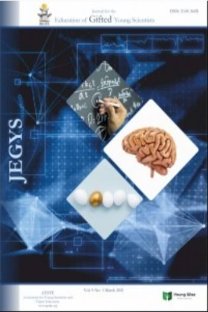Urgency Education Morals of Sufism in Millennial Era
Education Morals of Sufism, Attitude Education,
___
- Afify, A. A. (n.d.). Fi al-Tashawwuf al-Islam wa Tarikhikhi. Iskandariyah: Lajnah al Ta’lif wa al-Tarjamah wa al Nasyr.
- Abdullah, M. A. (2010). Islamic Studies di Perguruan Tinggi: Pendekatan Integratif-Interkonektif (2nd ed.). Yogyakarta: Pustaka Pelajar.
- Assegaf, A. R. (2011). Filsafat Pendidikan Islam: Paradigma Baru Pendidikan Hadhari Berbasis Integratif-Interkonektif. Jakarta: Rajawali Press.
- Bilqies, S. (2014). Understanding the Concept of Islamic Sufism. Journal of Education & Social Policy, 1(1), 55–72.
- Burhan, F. (Ed. . (1989). Postmodernisme Theologi. (F. (Ed. . Burhan, Ed.). San Fransisco: Harper & Row Publisher.
- Din, W. (2003). Sufism and the “Modern” in Islam. Studia Islamika, 10(3). Retrieved from http://journal.uinjkt.ac.id/index.php/studia-islamika/article/view/628
- Gunawan, H. (2012). Pendidikan Karekter: Konsep dan Implementasi. Bandung: Alfabeta.
- Hamka. (1990). Tasawuf Modern. Jakarta: Pustaka Panjimas.
- Hidayat, K. (2011). Memahami Bahasa Agama: Sebuah Kajian Hermeneutika. Bandung: Mizan.
- Howell, J. D. (2001). Sufism and the Indonesian Islamic Revival. The Journal of Asian Studies, 60(3), 701–729.
- Howell, J. D. (2010). Indonesia’s Salafist Sufis. Journal Modern Asian Studies, 44(5), 1029–1051. https://doi.org/doi:10.1017/S0026749X09990278
- Makhasin, L. (2016). Urban Sufism, Media and Religious Change in Indonesia. Ijtima’iyya, 1(1), 23–36.
- Mubarok, A. (2000). Jiwa dalam al-Qur’an. Jakarta: Paramadina.
- Mulyati, S. (2005). Mengenal dan Memahami Tarekat-tarekat Mukhtabarah di Indonesia. Jakarta: Prenada Media.
- Nasir, R., & Malik, A. A. (2013). Role and importance of sufism in modern world. International Journal of Advancements in Research and Technology, 2(1), 1–9.
- Nasr, S. H. (1991). Tasawuf Dulu dan Sekarang. Jakarta: Pustaka Firdaus.
- Nata, A. (2011a). Akhlak, Tasawuf dan Karakter Mulia. Jakarta: Raja Grafindo.
- Nata, A. (2011b). Akhlak Tasawuf. Jakarta: Rajawali Press.
- Polat, M. (2017). Tasawwuf-oriented Educational Philosophy and its Relevance to the Formation of Religion and Ethics Course Curriculum. Universal Journal of Educational Research, 5(5), 806–814. https://doi.org/10.13189/ujer.050514
- Ridhwan. (2017). Development Of Tasawuf In South Sulawesi. Qudus International Journal of Islamic Studies, 5(2). Retrieved from http://journal.stainkudus.ac.id/index.php/QIJIS/article/view/2412/pdf
- Rif’i, A. B., & Mud’is, H. (2011). Filsafat Tasawuf. Bandung: Pustaka Setia.
- Syukur, A. (2003). Tasawuf Kontekstual: Problem Manusia Modern. Yogyakarta: Pustaka Pelajar.
- Usman, S. (1982). Pengantar Ilmu Tasawuf. Medan: IAIN Sumatera Utara.
- Yamamoto, N. (2013). Understanding The Multidimensional Islamic Faith Through ‘ Abd Al-Ghanī Al-Nābulusī ’ S Mystical Philosophy. Al-Jami’ah, 51(2), 389–407. https://doi.org/10.14421/ajis.2013.512.389-407
- Zaini, A. (2016). Pemikiran Tasawuf Imam Al-Ghazali. Esoterik: Jurnal Akhlak Dan Tasawuf, 2(1), 146–159. https://doi.org/DOI: http://dx.doi.org/10.21043/esoterik.v2i1.1902
- Zamhari, A. (2013). Socio-Structural Innovations In Indonesia ’ S Urban Sufism: The Case Study of the Majelis Dzikir and Shalawat Nurul Mustafa Arif Zamhari. Journal of Indonesian Islam, 3(1), 119–144.
- Başlangıç: 2013
- Yayıncı: Genç Bilge Yayıncılık
Syamsul HUDA, Rizqi Amaliyakh SHOLİKHAKH, Nuraini Sri BİNA, Fitria LESTARİ, Beni HABİBİ, Putut SUHARSO
Muhamad IMADUDDİN, Anggun ZUHAİDA, Fitria Fatichatul HİDAYAH
Himawan PUTRANTA, Supahar SUPAHAR
Wattana SADUAK, Pakkapong POUNGSUK, Ratchadakorn PHONPAKDEE, Sataporn DEEYING
Hamza Omari MOKİWA, Elizabeth Umoh AGBENYEKU
Agus SALİM, Punaji SETYOSARİ, Waras KAMDİ, İ Wayan DASNA
Silvia MARNİ, Suyono -, Roekhan -, Titik HARSİATİ
Mardhiyyatin NAQİYAH, Dadan ROSANA, Sukardiyono -, Ernasari -
Zuhkhriyan ZAKARİA, Punaji SETYOSARİ, Sulton SULTON, Dedi KUSWANDİ
